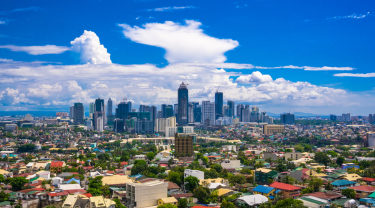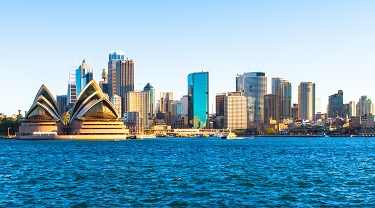Often referred to as the “Pearl of the Orient,” the Philippines has come out of its shell in recent years as one of the fastest-growing economies and most dynamic markets in Southeast Asia. This archipelago country of more than 7,000 islands represents vast export opportunities for Canadian businesses looking to expand into the Indo-Pacific region.
“The Philippines is an exciting market,” says Liew Chia Wan, who recently became Export Development Canada’s (EDC) first chief representative in the Philippines, leading a knowledgeable in-market team in the capital city of Manila. “It has a little bit of everything: Manufacturing, agriculture, a vibrant mining sector and a growing consumer base. The Philippines today stand out as a bright spot in the region.”
Sustained economic growth
With an economy that has more than doubled over the past 15 years, the Philippines has consistently outpaced many of its Southeast Asian neighbours. The country’s gross domestic product (GDP) grew at an average of 5.1% between 2013 and 2023, despite a brief slowdown during the pandemic, according to Nadeem Rizwan, an economist and country risk analyst at EDC.
This sustained growth—which can be attributed to a number of factors, including a young, growing population, rising consumer demand and major investments in infrastructure—has translated into greater demand for Canadian goods and services. Between 2019 and 2023, Canada’s exports to the Philippines increased by almost 71%.
The future looks even brighter for Canadian businesses looking to enter one of the most robust markets in the Indo-Pacific region for Canadian products and services. The economy is expected to grow on average by almost 6% in the next five years.
A young country with a growing middle class
Today, the Philippines has more than 114 million residents, making it the second-largest market based on population among the member countries of the Association of Southeast Asian Nations (ASEAN) and the seventh-largest in the Indo-Pacific region. Beyond its size, what’s also notable about the Philippine population is its youthfulness, with more than half of Filipinos under 25 years old.
This translates into a rich demographic dividend that few other countries can match, says Liew, “because this youthful population that’s coming up is educated, very trainable and have consumption power.”
Another demographic development with positive implications for Canadian exporters is the steady rise of the Philippine middle class. Rizwan notes that the Philippines is expected to gain 37.5 million new middle-class consumers by 2030. All told, the country’s total consumer base will account for about 1.5% of all consumers worldwide, according to the Brookings Institution, a non-profit research organization in Washington, DC.

Gateway to ASEAN opportunities
Canadian companies that do business in the Philippines will have access to more than one market and economy, says Liew. As part of ASEAN, the Philippines provides exporters with a gateway to developed economies in the region, like Singapore, and to manufacturing powerhouses such as Malaysia and Thailand.
“You also have emerging economies—frontier markets, like Laos, Cambodia and Myanmar,” says Liew. “So, in terms of variety that this region offers, it’s just unbeatable. And the Philippines is right in the middle of it all. This positioning makes the Philippines an ideal gateway for Canadian companies seeking a foothold in the broader Indo-Pacific region,” he says.
Lowering barriers for foreign businesses
In recent years, the Philippines has taken steps to reform its processes and make it easier for foreign companies to do business in the country. Building on a 2021 policy that reduced corporate income tax and brought in temporary tax breaks, the current government introduced further reforms that allowed new foreign investors to fully own Philippine-based companies and renewable energy projects.
In addition to a regulatory environment that’s evolving to be more business-friendly, the Philippines offers the added advantage of having English as a second national language that’s spoken by a large majority of the population. It’s also the country’s official business language, with virtually all commercial correspondence written in English.
Opportunities in many sectors
The Philippines’ expanding economy presents several key opportunities for Canadian exporters, particularly in sectors where Canada already has a competitive edge.
The growing middle class, coupled with increased consumer spending, is boosting demand for premium and healthy food products, making the Philippines an ideal market for Canadian exporters.
Canada has long been a reliable supplier of high-quality agricultural products to the Philippines, where Canadian wheat, pork, seafood and other agri-food products are well-regarded. According to Philippine government data for the first half of 2024, Canada is the third-largest supplier of pork and poultry and the ninth-largest supplier of beef to the Philippines.
Over the next decade, the import demand for beef from all source countries is projected to grow by nearly 3% annually, says Rizwan. This will be driven, in part, by the limited capacity in local production to keep pace with rising demand. With Canadian pork already a staple in Filipino diets, there’s also room for expanding exports of other high-quality, health-conscious food items such as organic products, seafood and processed foods.
Canadian businesses can also benefit from recent government initiatives aimed at improving food security in the Philippines. The establishment of the Indo-Pacific Agriculture and Agri-Food Office will further facilitate market access, helping Canadian exporters better understand the market and navigate local regulations.
Cleantech and renewable energy
As a country identified by environmental agencies to be among the most vulnerable to the effects of climate change, the Philippines has prioritized sustainability and renewable energy as key pillars of its economic strategy. In particular, the Philippine government aims to increase the share of renewables in the country’s energy mix to as much as 50% by 2040. For Canadian companies in cleantech—especially those focused on solar, wind, hydroelectric and waste-to-energy technologies—this could lead to new market opportunities.
Canadian expertise in energy management, grid infrastructure and emissions-reduction technologies can also play a significant role in helping the Philippines achieve its climate goals. Beyond energy, the Philippines is grappling with issues related to waste management and water quality—both areas where Canadian companies have considerable expertise. Canadians also have direct experience with water-related projects in the Philippines, having won several long-term contracts with some of the largest water companies in Metro Manila.
After decades of under-investment in infrastructure, the Philippines is working to catch up with a “Build Better More” (BBM) mandate. The current president, Ferdinand Marcos Jr., has prioritized 198 projects for development through an accelerated path for permitting, land allocation and funding. At the same time, the government has established the Luzon Economic Corridor (LEC) to accelerate co-ordinated investments in infrastructure projects—including rail, ports and clean energy infrastructure—between the country’s major economic centres in Manila, Subic Bay and Batangas.
Rizwan cites an S&P Global Market Intelligence report stating the Philippines has set a short- to mid-term target for infrastructure spending at between 5% to 6% of GDP. As of November 2023, the country had 198 flagship infrastructure projects, requiring roughly US$153 billion investment.
“Out of these 198 projects, 51.7% will be funded with foreign development assistance, so there’s limited opportunity there for Canadian businesses, but 16.3% will be funded by the Philippine government’s budget, so there might be opportunity there,” he says. “Then, there’s 25.8% that will be via public-private partnership, and that represents significant opportunity.”
Information and communications technology (ICT)
The Philippine ICT sector is booming. The digital economy grew by nearly 8% in 2023, driven by the country’s tech-savvy, young population and a burgeoning e-commerce sector. The Filipino government is investing in heavily digital infrastructure, with a focus on expanding broadband access and developing smart cities.
For Canadian companies in software development, cybersecurity, financial technology (fintech) and artificial intelligence (AI), the Philippines presents a wealth of opportunities. The rapid growth of the country’s digital economy means there’s a high demand for advanced technologies that can improve everything from online banking to e-commerce logistics. In particular, Canadian companies offering solutions for digital payments, fraud prevention and data security are likely to find a receptive market.
Additionally, the country’s thriving business process outsourcing (BPO) sector offers further opportunities for Canadian tech firms. Many multinational companies outsource their IT and customer service needs to the Philippines, and Canadian firms can capitalize on this trend by providing the digital tools and platforms necessary to support these services.

Business challenges in the Philippines
While the Philippines offers promising opportunities for Canadian business, it also comes with its share of challenges.
- Regulatory and bureaucratic hurdles. The Philippine government has taken concrete measures to streamline the country’s business environment, but bureaucratic inefficiencies remain and the regulatory landscape is relatively complex. Canadian companies need to plan carefully and allow for sufficient lead time to complete the necessary licensing and permitting processes for bringing products through customs.
- Infrastructure deficiencies. The Philippines has long struggled with under-investment in infrastructure, which affects both the efficiency of business operations and the ease and costs of transporting goods across the country. The country still lags other ASEAN nations in terms of transportation, logistics and utilities infrastructure. This also extends to issues with power supply, as the Philippines has the highest electricity tariffs in ASEAN, says Liew.
- Cultural and market adaptation. Canadian exporters who want to succeed in the Philippines need to understand the nuances of Filipino culture and adapt their products to fit local market preferences, says Liew. It’s also important to be familiar with Philippines business etiquette, which reflects a culture based on hierarchy, respect and relationships.
- Comparatively lower incomes. Even with its growing middle class, the Philippines is still a lower middle-income country, with per capita GDP of around US$3,800 (not adjusted for inflation and cost of living), according to Epic Research. This means that certain premium or luxury products may appeal only to niche markets. For Canadian exporters, it’s vital to offer products at price points that match the purchasing power of the local population.
- Competitive environment. Canadian exporters face strong competition from regional players, like Japan—where EDC recently opened a new representation—South Korea and China. In particular, says Rizwan, Canadian companies need to be aware of the intense race for market share in sectors like agri-food, where Canadian exporters of pork and beef face stiff competition from Brazil, the United States and other countries.
- Geopolitical and regional dynamics. The Philippines’ geopolitical situation can also present challenges. Its relationship with China, for example, is complex and has implications for trade and investment, creating uncertainty for Canadian exporters looking to do business in the region. To navigate potential risks, Canadian exporters need to stay informed about regional political dynamics and adjust market strategies accordingly.
- Corruption. The Transparency International’s Corruption Perceptions Index for 2023 showed an improved score for the Philippines from the previous year. Nonetheless, as a risk reduction and environmental, social and governance (ESG) best practice, Canadian exporters should conduct proper due diligence on potential partners, suppliers and customers.
How EDC can help
Despite these challenges, Canadian businesses can succeed by leveraging the resources and support provided by EDC and the Canadian Trade Commissioner Service (TCS). EDC’s new representation in Manila will be essential in giving Canadian companies access to critical market intelligence, local contacts and financial tools, like trade credit insurance. Offering credit and flexible payment terms, supported by EDC credit insurance, can also give Canadian companies a competitive edge in a market where flexible financing is key.
About Export Development Canada
EDC is part of the Government of Canada’s trade ecosystem of experts available to help you save time, learn more about your target markets and identify the capital you need to grow.
As part of our Indo-Pacific strategy, EDC’s committed to helping Canadian companies diversify into new markets and succeed in this dynamic region. Through our new Philippine representation, EDC’s experienced team is well-positioned to offer the industry insights, knowledge and tools you need to succeed in the Philippines. EDC also offers:
- A full suite of credit insurance products to lower your risk for doing business abroad
- Guarantees to help you get access to working capital
- Expertise to enable you to learn more about international markets
- Connections to international companies in need of your products and services
Learn more about how EDC’s financial and knowledge solutions can help you understand the opportunities in your target market and make exporting less risky. To contact an EDC export advisor, visit our Export Help Hub.
Trade Commissioner Service (TCS)
Canada’s TCS in the Philippines has a team of trade professionals stationed in Makati City, part of the capital city of Manila. With specialized knowledge of key sectors, they excel at forging relationships with associates who can help Canadian companies do business in the Philippines.
Interested in growing your business in the Philippines and the Indo-Pacific?
Connect with EDC and watch your business flourish on the international stage.
Answer a few questions about your company to learn more about how EDC can help you plan, connect and fuel your expansion in the Indo-Pacific.



